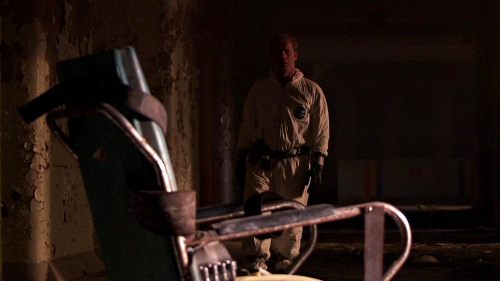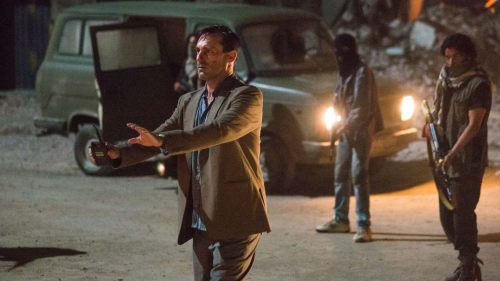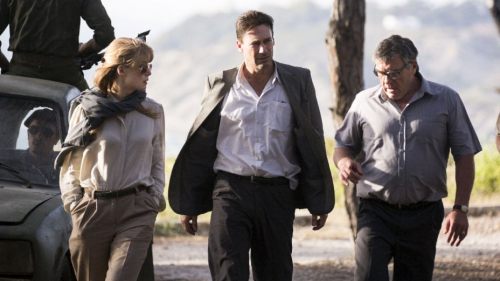How A Burnt Ziti Gave Us SESSION 9
In 2000, director Brad Anderson decided to turn his attentions to the horror genre. Following the modest success of two romantic comedies (1998's Next Stop Wonderland and 2000's Happy Accidents), this was a notable change in gears for the Boston-based filmmaker, but he felt he had a story well worth telling: in mid-1995, a local businessman named Richard Rosenthal had returned home from work to discover that his wife had accidentally burned his ziti dinner, and, in a fit of inexplicable rage, Rosenthal murdered her before cutting out her heart and lungs. He then placed them on a stake in the backyard and went back to work the next day as though nothing had ever happened (more details on the case here). Eventually he was caught, but Rosenthal claimed to have zero memory of the incident: he'd apparently blocked it from his memory completely.
The crime shocked and fascinated the people of Boston, Anderson included. Around the same time, the director became intrigued by a long-since abandoned mental hospital he'd seen along Massachusetts' Route 93: the infamous Danvers State Mental Hospital (founded in the late 1800s and seen below), where untold scores of patients had been subjected to cruel shock treatments and lobotomies. After touring the sprawling, wildly disturbing ruins of the place with a crew of "urban explorers" he'd met online, the filmmaker was convinced he'd stumbled upon the perfect location for a psychological horror movie.
Along with actor/writer Steve Gevedon, Anderson combined a fictionalized account of the Rosenthal case with the backdrop of Danvers to form the screenplay for 2001's Session 9. The film - shot on-location at Danvers during the back half of 2000 - eventually premiered at the 2001 Fantasia Film Festival to strong critical reception before opening in theaters in August of that year. Shot in a terrifying location by a relatively successful indie-film director and starring actors Peter Mullan, David Caruso, Josh Lucas, Brendan Sexton III, and co-writer Gevedon (as "Mike King"), the film seemed to have all the makings of a Blair Witch-style indie horror hit.
Needless to say, it did not become a Blair Witch-style hit.
The reasons why are legion: one could reasonably say that it was undermarketed, that its star power wasn't strong enough, that an often brutal horror film opening in the weeks preceding the attacks of September 11th was doomed to be ignored by a grieving public, that its coverbox and poster didn't "sell" the film well enough (see above). Whatever the case may be, there's no doubt that Session 9 failed to connect with audiences at the time of its release: it came and went from theaters within the space of a month, never screening in more than 57 theaters across the country.
C'est la vie. Just about all involved went on to find success in other projects (Anderson went on to direct multiple episodes of Fringe as well as Christian Bale's jawdropping performance in 2004's The Machinist; Mullan went on to appear in the brilliant Red Riding Trilogy and a handful of Harry Potter films; Caruso become a really solid internet meme). It's true that Session 9 has become a bit of a cult film in the years since its release, but, if ya ask me, there are still far too many film geeks out there who seem unaware of it.
Thankfully, we live in the Golden Age of Netflix, so any of you who remain unfamiliar with this criminally underrated gem can get onboard the Session 9 bandwagon immediately. Here's the setup: Gordon (Peter Mullan, in one of his best performances...which is saying something) and Phil (David Caruso, here delivering the best line reading of the phrase "Fuck you" ever seen on film) play two guys who run an asbestos-removal company operating out of Boston, Mass. We meet them just as they encounter Danvers Hopsital for the first time. They're there to bid on a massive clean-up job being organized by the local government, and almost immediately the location helps drench the film in dread: we take the tour with Gordon and Phil, winding through the dilapidated hallways, crumbling patients' quarters (where the walls are covered in creepy old photographs and graffiti, all of it very real), and "hydrotherapy treatment" rooms that make up the sprawling wings of Danvers, and just the sight of the place is enough to get your heart beating a little quicker.
The hospital's long-since been demolished, but, were it still standing, there's no way in hell I'd set foot in the place even in broad daylight. Here's how Caruso described filming in the location:
Danvers is not a movie location. It really is [a mental hospital]. It was a place we never got comfortable in. It wasn't like it was day three, and you were throwing water balloons because it was so much fun to be there. It was always scary, and you could really feel the pain of the people that were at Danvers. It's a rough environment. But, I mean, it's on the film. You can see. They didn't have to dress any sets or anything, all that stuff was already there. The federal government walked away from it about thirty years ago, and it was a terrifying location.
Believe it. Anyway, upon taking the tour, Gordon makes a rash bid on the job, promising to have it completed weeks sooner than the highest bidder, and for the same price. Phil is obviously concerned about this, but Gordon explains that he really needs the cash...and besides, if they hire enough guys and work really hard (maybe even throw in a sizable bonus, just to keep morale up), there's no reason they can't get it done. Reluctantly, Phil agrees, and with that the job is theirs.
I will not spoil any further plot details. Watching Session 9 unfold for the very first time is an absolute pleasure: creepy facts about Danvers Hospital are littered throughout the film (not to mention the sight of one horrifying room after another), along with a few gruesome deaths (to satisfy the gore-hounds), a number of extremely strong performances (Mullan, Caruso and Josh Lucas all turn in fantastic work here), one or two red herrings, and an utterly satisfying ending that...well, it's hard to say anything about the ending of Session 9 without getting into spoiler territory, to be honest. But I will say that it keeps things vague enough to allow you to put a few of the puzzle pieces together on your own without feeling like the script ever cheats.
This is not a typical slasher film, though it may sound as though it has the makings for one. There's a strong undercurrent of despair here (the image that sticks with me long after the film isn't a particularly nasty gore effect, but of Peter Mullan, utterly confused and shell-shocked, sitting amidst the tombstones of the Danvers Hospital graveyard mumbling, "I just want to go home"), despair that will stick with you long after seeing the film. Knowing that the film was shot where hundreds of mental patients were lobotomized, given shock treatments and/or died absolutely...lemme tell ya, it absolutely informs the horror. It makes it feel personal.
Additionally: I was not aware of the Richard Rosenthal case that inspired the film until somewhat recently, and I can confirm - for those of you who saw the film long ago and weren't planning on revisiting it any time soon - that knowing the facts of the case greatly accentuates the film's horror. I rewatched the film for the first time in about a year in preparation for writing this piece, and the sequences that directly deal with the Rosenthal case (you'll have to watch to find out how that ties in) were given a whole new depth, one that left me infinitely more creeped out than those scenes ever had in the past.
So, do yourselves a favor. Track down a copy of Session 9 via Amazon.com (link helpfully provided below) or just look the film up on Netflix Instant the next time you're in the mood to be blown away by a really well-crafted, beautifully shot little horror indie. If you don't have at least one troubled night of sleep in the wake of that screening, well, you're stronger than I.



